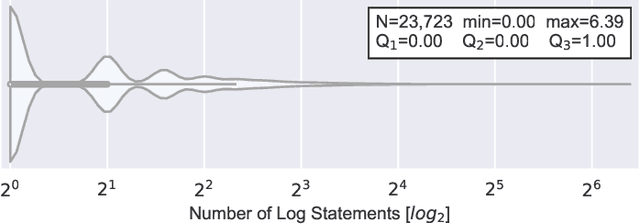Maurício Aniche
An Exploratory Study of Log Placement Recommendation in an Enterprise System
Mar 10, 2021



Abstract:Logging is a development practice that plays an important role in the operations and monitoring of complex systems. Developers place log statements in the source code and use log data to understand how the system behaves in production. Unfortunately, anticipating where to log during development is challenging. Previous studies show the feasibility of leveraging machine learning to recommend log placement despite the data imbalance since logging is a fraction of the overall code base. However, it remains unknown how those techniques apply to an industry setting, and little is known about the effect of imbalanced data and sampling techniques. In this paper, we study the log placement problem in the code base of Adyen, a large-scale payment company. We analyze 34,526 Java files and 309,527 methods that sum up +2M SLOC. We systematically measure the effectiveness of five models based on code metrics, explore the effect of sampling techniques, understand which features models consider to be relevant for the prediction, and evaluate whether we can exploit 388,086 methods from 29 Apache projects to learn where to log in an industry setting. Our best performing model achieves 79% of balanced accuracy, 81% of precision, 60% of recall. While sampling techniques improve recall, they penalize precision at a prohibitive cost. Experiments with open-source data yield under-performing models over Adyen's test set; nevertheless, they are useful due to their low rate of false positives. Our supporting scripts and tools are available to the community.
The Prevalence of Code Smells in Machine Learning projects
Mar 06, 2021



Abstract:Artificial Intelligence (AI) and Machine Learning (ML) are pervasive in the current computer science landscape. Yet, there still exists a lack of software engineering experience and best practices in this field. One such best practice, static code analysis, can be used to find code smells, i.e., (potential) defects in the source code, refactoring opportunities, and violations of common coding standards. Our research set out to discover the most prevalent code smells in ML projects. We gathered a dataset of 74 open-source ML projects, installed their dependencies and ran Pylint on them. This resulted in a top 20 of all detected code smells, per category. Manual analysis of these smells mainly showed that code duplication is widespread and that the PEP8 convention for identifier naming style may not always be applicable to ML code due to its resemblance with mathematical notation. More interestingly, however, we found several major obstructions to the maintainability and reproducibility of ML projects, primarily related to the dependency management of Python projects. We also found that Pylint cannot reliably check for correct usage of imported dependencies, including prominent ML libraries such as PyTorch.
 Add to Chrome
Add to Chrome Add to Firefox
Add to Firefox Add to Edge
Add to Edge